Tennis star Rafael Nadal could not have won the French Open title without “some anti-inflammatory” in his problem foot. Football veteran Zlatan Ibrahimovic survived a large part of AC Milan’s past championship season with a broken cruciate ligament only thanks to painkillers. Liverpool’s Thiago kicked his foot in the Champions League final after receiving a pain-relieving injection. The use of painkillers in top-class sport is sometimes alarming.
Doctors and doping experts warn of dramatic health consequences and call for more sensitive use of ibuprofen and Co. They do not believe in improvement. It’s about drugs that reduce fever, inhibit inflammation or numb pain, so-called nonsteroidal anti-inflammatory drugs (NSAIDs). Substances whose active ingredients are too weak to end up on the World Anti-Doping Agency (WADA) banned list and which are usually available without a prescription.
“Except in special situations, such as Nadal’s chronic pain, the drugs are often taken prophylactically by professionals. That’s abuse,” said sports physician Wilhelm Bloch from the German Sport University in Cologne. The expert estimates that, depending on the sport and category, more than 50 percent of the participants now regularly take painkillers.
This is what everyday life in competitive sports often looks like, said Bloch and reported on clubs in which painkillers are common. “It’s like a bowl of Smarties, almost everyone grabs it.”
Is that already doping?
Experts keep discussing whether abuse of painkillers is doping. “Critical. In principle, it’s about increasing performance,” said Bloch. “Athletes reach a pain threshold under high stress. By taking painkillers, many try to push this limit in order to perform longer,” explained the expert.
So why not put the substances on the doping list? “It’s a hopeless fight. In principle, you’re powerless when it comes to painkillers,” said doping expert and pharmacologist Fritz Sörgel. “It would go all the way to the Federal Constitutional Court if you weren’t allowed to take painkillers.”
Instead of issuing bans, the German Nada, for example, tries to talk to athletes about the reasons and effects of painkiller abuse and to show sensible alternatives. In addition to behavioral preventive measures, a changed understanding of the system is also needed – in the environment of athletes as well as in society, it said.
Ivan Klasnic “poisoned”
The Croatian ex-soccer player Ivan Klasnic is one of the most well-known sports cases in the German-speaking world for painkiller use and its consequences. The former Werder Bremen player said he was “toxically poisoned”. “Because I was given painkillers that I wasn’t allowed to have.” The drugs destroyed his kidneys and led to three kidney transplants. A legal dispute with his former doctors ended in 2020 with a settlement.
In addition to kidney damage, Bloch primarily mentions “liver and vascular damage” as possible consequences of long-term medication. “And in endurance athletes such as marathon runners, where microbleeds are more common in the gastrointestinal tract anyway, nonsteroidal anti-inflammatory drugs can increase bleeding.” In addition, the drugs could influence the healing process after injuries. “The ability of the tissue to regenerate is sometimes limited,” explained Bloch.
The list of athletes who use painkillers can be continued behind Nadal and Thiago. The German football top man Toni Kroos revealed last year that he had played “six months on painkillers” due to an injury. And the Norwegian ski world champion Henrik Kristoffersen, who was able to ski down the piste again one day after a fall in 2015, reported at the time: “My hip is all blue. It hurts. I took a painkiller – here I am.”
zan
Source: Nachrichten




